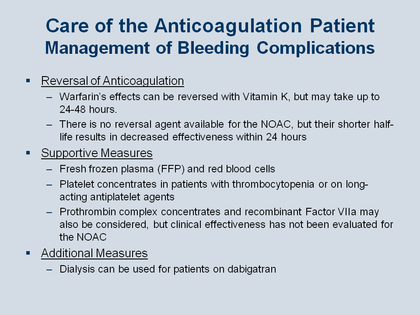Steven A. Rothman, MD - AFib Treatment: General Population - Figure 32
Management of Bleeding Complications
As discussed in previous Figures, one of the major reasons that physicians fail to maintain adequate anticoagulation therapy in their patients is the worry about bleeding risk. What happens when a patient on anticoagulation therapy has a bleed?
The anticoagulant effect of warfarin can be reversed with vitamin K, but this can require up to 24 to 48 hours to take effect.
What about the NOACs? At present there is no reversal agent available for the NOACs; however, in addition to their rapid onset of anticoagulant effectiveness, the NOACs have short biologic half-lives, which will usually result in decrease effectiveness within 24 hours. As discussed by Dr Reiffel, patients who are being treated with one of the NOACs and have bleeding complications should get supportive measures including fresh frozen plasma and packed red blood cells, along with platelet concentrates if they have thrombocytopenia, or long acting antiplatelet agents. In addition data are starting to appear about the use of prothrombin complex concentrates and recombinant Factor VIIA agents that can be considered.
Rothman SA. Am J Med 2013; 126: 00-00.

